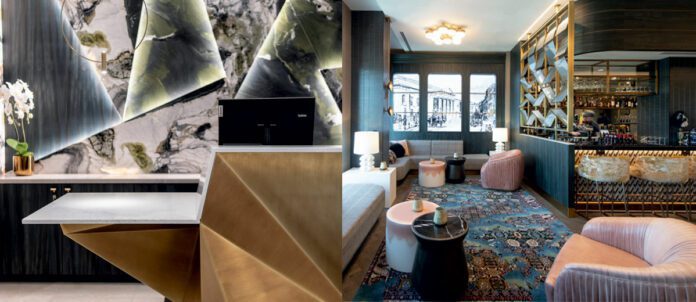The basic concept of a hotel room hasn’t changed over the centuries. It’s still a place to relax while on vacation or work on a business trip in a clean, quiet, safe place. Today, however, operators and developers are pressed to consider the seismic shift brought on by COVID. Common spaces were impacted, traditional surfaces were swapped out for easily cleaned materials, and tech took over the front desk. By most accounts, these changes are here to stay. Adele Rankin, managing principal of Vancouver-based hospitality and residential studio CHIL Interior Design, says her firm has been called upon to re-imagine everything from storage space to work surfaces to ping-pong tables. She says because many hotels no longer offer housekeeping every day whether that’s in response to staff shortages or guests who are uncomfortable with people in their room there’s been a demand for more storage.
“If you’re not getting [your room cleaned] every day, you need enough space to hang towels properly and put your things away,” she says. “So, we’ve been providing discreet storage solutions in areas like the base of the bed, or accessories within the bathrooms that allow for additional hanging and storage.”
She says all the furniture that CHIL designs strikes a balance between maneuverability and quality. “It has to be sturdy enough to withstand the wear and tear that hotel rooms experience, but at the same time have ultimate flexibility. For example, does the guest want to sit on a window seat with a laptop? Do they want to eat off of a side table as well as use that to conduct a Zoom meeting? Do they want a great backdrop for a virtual meeting?”
She says the demand for more outlets continues, especially since people are on their devices in more places, whether it’s at a bar, communal work table or banquette.
Rankin says in the past, meeting rooms were almost always large, open spaces that could be subdivided. Now, with many businesses conducting hybrid meetings, spaces range from accommodating four to eight people to individual ‘Zoom rooms.’
“Meetings aren’t just about boardroom tables anymore; they’re more about gathering in a circle, sitting in sofas or lounge chairs.” She adds that meeting furniture also needs to have a dual purpose. “We recently designed a ping-pong table that [could be converted] to a boardroom table.”
Rankin says having the flexibility for events to bleed into outdoor space that is well-designed so it’s not just a brick-paver courtyard is important. “It’s about built-in landscape seating that’s just as high quality as it is on the inside. Also, for all seasons, fire tables are becoming a huge trend.”
Smart Design
Before COVID wreaked havoc across the industry, Wyndham Hotels & Resorts was already addressing the need for smart, minimalist designs with its 2020 opening of the 63-room Microtel by Wyndham in George, Wash., the first to feature the brand’s highly efficient Moda prototype. Back then, cleanliness and efficiency were top of mind and now, with all the lessons the pandemic taught, they’re even more essential.
David Kellam, vice-president, Architecture Design & Construction, Wyndham Hotels & Resorts, says, “We did away with larger, bulkier case goods and replaced them with wall-hung units, which allow for easier and faster cleaning for our guestroom attendants. We also eliminated drawers, reduced the number of cubbies, which are essentially dust collectors. We also offered luxury tile flooring in our guestrooms for our owners. In our public-area flooring, where we have carpet, we introduced carpet tiles, which are both easier to clean and maintain. If you have a spill or stain you can replace a tile versus an entire room.”
As for energy efficiency and reducing its footprint, Kellam says designers re-worked Microtel’s pitched roof, angles and turns, which cost more to design and construct. “We made that pitched roof multi-angle façade into a box and reduced the turns and angles. We also flattened the roof, which provided a very modern, attractive façade. We opened up the lobby area and put in floor-to-ceiling glass because we wanted people on the outside to see the warmth on the inside.”
Wyndham opened its first Microtel featuring the Moda prototype in Canada last year with its Microtel Inn & Suites in Lac-Megantic, Que. Two more are set to launch, one later this year in Prince Edward Island, and another early next year in La Chute, Que. The company has about 110 more hotels with the Moda prototype in the pipeline, with 13 of those planned for Canada.
BY ROBIN ROBERTS


















